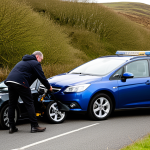Understanding Car Immobilizer Systems and Their Role in Security
Car immobilizer systems are a cornerstone of modern vehicle security, designed to prevent unauthorized engine start. These systems typically function by requiring a coded signal from a key transponder or fob that communicates with the car’s electronic control unit (ECU). Without this correct code, the immobilizer disables crucial engine components, effectively stopping the vehicle from starting.
In the UK, car immobilizer systems are widely adopted due to stringent regulations aimed at reducing vehicle theft. There are several common types in use. The most prevalent include transponder-based immobilizers, where the key contains a chip that emits a unique electronic code, and smart key systems, which rely on proximity detection to allow engine start only when the correct key is nearby.
Also to read : Mastering ECU Diagnostics: Your Ultimate UK Handbook for Identifying and Fixing Common Vehicle Problems
The importance of immobilizers in UK car security cannot be overstated. By disabling the ignition, fuel, or starter circuits, immobilizers act as a formidable barrier to theft, significantly lowering the chance that a vehicle will be stolen. This technology complements other security features like alarms and GPS tracking, creating multilayered protection that deters both opportunistic and professional thieves. Understanding how these systems work highlights why they are integral to securing vehicles in the UK environment.
Legal Framework for Immobilizer Bypass in the UK
Understanding the legal bypass immobilizer regulations in the UK is crucial before attempting any immobilizer removal or bypass. UK law strictly prohibits bypassing an immobilizer system for theft or unauthorized driving. However, exceptions exist when bypassing is necessary for legitimate car maintenance or repair, provided proper protocols are followed.
Additional reading : Complete Guide to Fixing Faulty Electric Windows in UK Vehicles: Your Step-by-Step Troubleshooting Handbook
The law mandates that any immobilizer bypass must be clearly documented and justified as part of authorised car maintenance. Vehicle owners or garages should maintain detailed records proving the bypass aligns with car maintenance regulations and is not intended to facilitate theft. This legal framework distinguishes between lawful maintenance actions and illegal tampering.
Importantly, only trained professionals adhering to UK vehicle security standards should perform immobilizer bypasses. They must ensure that once maintenance is complete, the immobilizer system is fully restored to maintain ongoing vehicle security.
Failing to comply with these legal requirements can lead to severe penalties, including fines and invalidation of insurance coverage. Keeping comprehensive documentation not only protects the vehicle owner legally but also supports transparency with insurers and authorities.
In summary, the UK’s legal approach to immobilizer bypass balances the necessity for authorised car maintenance against the need to prevent misuse, reinforcing the integrity of UK car security standards.
When Bypassing the Immobilizer is Necessary for Maintenance
Bypassing the immobilizer can be essential during specific car maintenance activities. For instance, replacing the ECU, repairing the ignition system, or reprogramming key transponders often requires temporarily disabling the immobilizer to access and test engine functions. This ensures technicians can perform necessary diagnostics or parts replacement without permanent interference.
Following UK garage procedures is critical. Manufacturers usually prescribe detailed steps for immobilizer bypass tailored to each vehicle model, ensuring secure temporary override without compromising overall vehicle security. Ignoring these recommended methods risks damaging vehicle electronics or triggering false alarms.
Clear communication of bypass intent with authorised service professionals is mandatory. Garages must document why the bypass occurs, linking it directly to car maintenance. This transparency safeguards against misuse and aligns with UK regulations governing immobilizer systems.
Ultimately, these controlled bypass scenarios allow legitimate repairs while maintaining the stringent security standards expected in UK car security. The temporary nature of authorized bypass demands restoring the immobilizer immediately once maintenance concludes, preserving ongoing theft deterrence.
Secure and Legitimate Methods to Bypass Your Immobilizer
When performing a secure bypass of car immobilizer systems, following approved immobilizer bypass methods is crucial to maintain UK safety practices. The process generally begins with obtaining manufacturer guidelines, which vary by vehicle make and model. These instructions ensure the bypass is temporary and reversible without compromising vehicle security.
Technicians typically employ diagnostic tools authorised for UK vehicles to safely interrupt the immobilizer signal. This may involve using specialized key programmers or ECU reflash devices. Such tools prevent permanent damage and limit the risk of later system failures. Importantly, every step should be documented to align with UK regulations about car maintenance.
Safety precautions include disconnecting the vehicle’s battery before starting, working in an electrostatic-safe environment, and ensuring that only qualified personnel perform the bypass. These measures reduce risks like electrical shorts or false immobilizer triggers, which can lead to costly repairs.
A secure bypass always ends with restoring the original car immobilizer system settings, ensuring full functionality. This reversibility supports ongoing theft prevention and complies with the UK’s legal framework. By adhering to these legitimate methods, garages and owners can confidently manage necessary immobilizer bypass tasks without undermining UK car security standards.
Risks and Potential Issues with Immobilizer Bypass
Temporary immobilizer bypass carries significant immobilizer bypass risks that directly impact car safety and system reliability. One primary risk is potential permanent damage to electronic control units or security modules if bypass procedures are not meticulously followed. Damaging these delicate components can cause system malfunctions beyond immobilizer failure, affecting overall vehicle operation.
Another critical concern is voiding vehicle warranties. Many manufacturers stipulate that unauthorized immobilizer tampering invalidates warranty coverage. Additionally, insurers may refuse claims if immobilizer bypass documentation is missing or the bypass appears linked to theft or negligence. This underscores the necessity of abiding by strict car maintenance protocols and ensuring full restoration post-bypass.
System integrity may also be compromised if the bypass is not properly reversed, leading to immobilizer errors or inability of the vehicle to recognise authorised keys. Such issues can render the car unreliable or even immobilised, requiring costly dealership intervention.
To mitigate these risks, technicians must use approved tools following manufacturer guidelines, document every step, and verify full system functionality after maintenance. Vigilant adherence to UK vehicle security standards ensures the bypass process supports legitimate repairs without undermining overall security or safety.
Troubleshooting Immobilizer Bypass Problems
When the immobilizer bypass is not working correctly, owners often face frustrating issues such as the engine failing to start or the car not recognising authorised keys. Troubleshooting immobilizer failures requires a structured approach to identify if the problem stems from bypass errors or original system faults.
First, verify that the bypass process was properly documented and executed using approved methods. An incorrect or incomplete bypass can cause the immobilizer system to reject signals or trigger false alerts, directly affecting UK car security. Diagnostic tools authorised under UK regulations can scan for fault codes, revealing whether errors originate in the bypass components or elsewhere.
Common remedies include reprogramming key transponders, resetting electronic control units, or restoring factory immobilizer settings. Often, a simple reset can re-enable communication between the key and vehicle’s ECU. If errors persist, it may indicate hardware damage during bypass, requiring expert intervention.
Restoring the original immobilizer system is vital to maintain vehicle security. Always use professional UK vehicle support services when troubleshooting complex immobilizer bypass issues, ensuring compliance with legal requirements and protecting the car’s security infrastructure. Proper troubleshooting safeguards both safety and warranty validity while preventing immobilizer-related immobilisation.
When to Consult a Professional
Knowing when to seek help from car security professionals is critical for ensuring a safe and legally compliant immobilizer bypass. If the immobilizer bypass process involves complex ECU reprogramming, faulty immobilizer components, or persistent immobilizer errors, it is essential to contact an UK auto locksmith or authorised specialist with experience in vehicle security systems. Attempting amateur bypass or repair increases the risk of system damage and legal complications.
A reputable car security professional will follow UK regulations, use approved diagnostic equipment, and provide documented proof of maintenance. Their expertise ensures that immobilizer bypass is executed securely, minimizing risks to vehicle safety and warranty status. When choosing an expert, verify their credentials, ask for references, and confirm familiarity with the specific vehicle make and model’s immobilizer system.
Clear communication about your maintenance needs is vital. Professionals must understand why the immobilizer bypass is necessary and adhere strictly to legal and insurance requirements. This partnership protects both the owner’s interests and complies with UK vehicle security standards, ensuring that immobilizer bypass remains a controlled and responsible procedure.
Understanding Car Immobilizer Systems and Their Role in Security
Car immobilizer systems are vital components in modern vehicles, designed to enhance vehicle security by preventing unauthorized engine starts. Typically integrated with the vehicle’s electronic control unit (ECU), these systems require a specific coded signal from a transponder key or fob to enable engine ignition. Without this authentication, critical engine functions are disabled, making theft attempts significantly more difficult.
In the context of UK car security, immobilizers serve as a frontline deterrent against vehicle theft. The most common types implemented include transponder-based immobilizers, which use chips embedded in keys to transmit unique identification codes, and proximity-based smart key systems that allow engine start only when the key is within range. Both types ensure that starting the vehicle without the correct key is virtually impossible.
This technology not only safeguards the vehicle but also complements additional security measures such as alarms and tracking systems. By integrating immobilizers, the UK’s stringent security standards ensure that vehicles enjoy substantial protection from both opportunistic thieves and professional criminals. Understanding their operation highlights why immobilizers are indispensable in today’s automotive security landscape.




